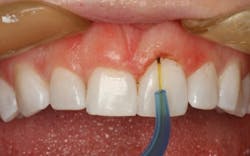Digital dentistry, chairside CAD/CAM, and restorative dentistry – my journey
by Dr. Robert Mongrain
For more on this topic, go to www.dentaleconomics.com and search using the following key words: digital dentistry, CAD/CAM, restorative dentistry, Dr. Robert Mongrain.
After graduating in 1979 from the University of Florida, I embarked upon my journey in dental practice. I began a lifelong pursuit of new knowledge through clinical and practice management education.
As I went from new graduate to seasoned practitioner, I discovered the techniques and materials that were originally available to me did not always provide the clinical solutions my patients and I were seeking.
One area in which I found a need to improve my clinical practice was crown and bridge and indirect restorations. The primary restorative option we have had, the porcelain-fused-to-metal crown, is costly of tooth structure. In addition, it sometimes has postoperative issues with unexpected endodontic therapy, and it does not fully meet patients’ esthetic desires (the dreaded "black line").
When using a coping reinforced crown, whether the coping is metal or zirconia, the preparation is driven primarily by the needs of mechanical retention and the limited esthetics of the coping – not by the damage suffered by the tooth.
The esthetics of lab ceramics helped me overcome this issue with highly esthetic materials. But this results in other obstacles. The high cost of lab fees, difficulties with temporizing less-retentive preparations, and the additional time required for adhesive bonding made these more esthetic restorations more expensive for my patients.
In the mid 1990s, I began to investigate chairside CAD/CAM as a potential solution to this issue. My primary motivation was not so much to be high tech, but was more about finding an economical and clinically excellent way to provide new restorative options for my patients.
I wanted the best dentistry I could provide that would mesh with the desire of patients to have esthetically pleasing, conservative restorations, whether they were inlays, onlays, or crowns. So I embarked on my journey and have pursued it ever since.
Several years ago, I saw a new technology at the Chicago Midwinter dental meeting that promised an image in the mouth without the use of contrast agents or opaqueing mediums. It was in development for some time, but in the spring of 2007, I experienced my first clinical use of the D4D Technologies E4D system.
While the technology continued to develop, I followed and incorporated it into my clinical practice full time in the fall of 2007.
Same-day dentistry with the E4D system allows me to provide a type of dentistry that was not always available in an economical fashion using a laboratory. All ceramic restorations can be completed in a single visit in a time frame that is similar to the total chair time it would take to complete a traditional PFM.
My patients like the fact that I do not have to prepare their teeth in the same way. What I have found over and over is that most people "want it white." So the opportunity to eliminate the black line has a big influence in treatment acceptance.
Eliminating the challenges of temporaries overall, and especially the difficulty temporizing conservative preps, has been a significant benefit to my practice.
There were several factors that drew me to the new system. First and foremost was eliminating the need to powder or opaque the tooth for imaging. I feel strongly that this is a significant benefit. It simplifies the process and reduces potential for error that can come with improper powdering or opaque application.
Fig. 2: A screen shot of the E4D design software showing the crown as designed with the occlusal contacts, ready to be milled.
When ready to proceed, we just blow some air on the tooth and continue. I have not sprayed opaquer on teeth since I began to use the new system.
A second significant impact has been the ease of use of the software for me and my staff. I have achieved almost complete delegation of design functions and other delegatable functions with the new system.
Both of my assistants learned to operate the system quickly. It is intuitive, which I know is almost a cliché now, but no real computer knowledge is required to use the software.
With some training and practice, nearly everything can be determined and readily understood. In addition, with the ability of the support team to log directly into my system on demand, it is like having the trainer in the office.
It is such an amazing advance, having an expert in dental design, software use, or technical system issues available by logging into your system. Within seconds to minutes of completing a phone call you can solve problems almost as if the expert were on site.
In industrial CAD/CAM systems, the use of multiple tools is common. As our materials evolve and advance, different tool shapes and types will be necessary. The E4D milling unit currently has the capability to hold three tools on each side of the milling chamber. This allows for multiple tool types with automatic tool detection and replacement, as well as flexibility for future material development with the current milling unit.
Fig. 3: Post-op. This shows the completed crown bonded to the premolar.
Chairside CAD/CAM offers this opportunity, especially with the new system that provides a superior service to patients. The lack of impression taking, having to wear a temporary, and returning for a second visit seems to be normal when a dental practice has never used chairside CAD/CAM.
Once you take the step into this technology, you find yourself saying, "I could never go back to my previous way of doing dentistry." I cannot imagine practicing any other way after 12 years of same-day dentistry. My patients do not want to return to the old way either. The benefits for patient and practice are significant.
The E4D Dentist CAD/CAM system enables the dental practice to scan, design, and mill restorations in the office – often in a single visit.
The new system is a comprehensive restorative system for chairside use. It can scan soft tissue and tooth structure, preoperative situations, preparations, and bite registration materials without the need for a contrast agent or opaqueing medium, such as powder or sprays.
When used with impressions, the system even inverts the image to create a virtual model. After scanning, the software creates a model and the design process begins. Autogenesis provides an optimized restoration design that uses information from the opposing dentition (bite) or preoperative condition, wax-up, or scans of the provisional restorations.
The design tools provide the ability for all members of the dental team to control every aspect of design. The approved design is sent wirelessly to the milling machine, where it takes just minutes to fabricate a high-strength ceramic or composite restoration (Ivoclar IPS Empress, IPS e.max CAD, 3M ESPE Paradigm C, Paradigm MZ100).
Dr. Robert Mongrain is in private practice in Tulsa, Okla. He is an adjunct faculty at the University of Oklahoma College of Dentistry. He is also a consultant to Brain-Pad Inc., which develops new applications for patented dual-arch mouth guard technology. Dr. Mongrain has been a board member of the Academy of CAD/CAM Dentistry, an instructor with Dentistry By Design, and an ISCD internationally certified trainer. Reach him by e-mail at [email protected]. For seminar availability, contact Dr. Mongrain.
Past DE Issues


